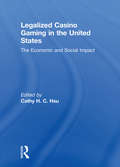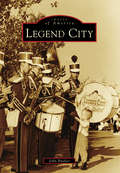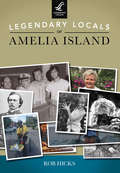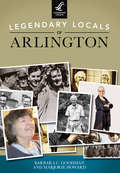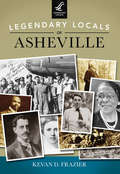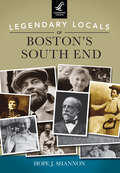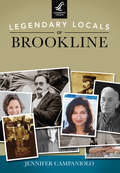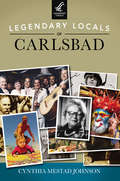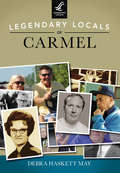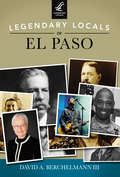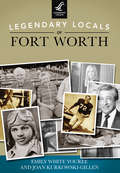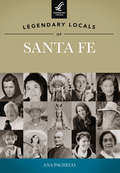- Table View
- List View
Lee County, Texas
by Nancy Hamilton Lee County Historical CommissionLee County illustrates the region's history through vintage photographs, many of which are previously unpublished. This truly multi-cultural, central Texas county is home to a variety of ethnic communities, including the Wends of Serbin and the Czechs of Dime Box, as well as the more diverse settlements of British and German immigrants and former slaves throughout the county. This pictorial retrospective of Lee County begins before the county was formed and continues to about 1940. Narratives taken from local citizens' letters, diaries, and memoirs provide an informative commentary, and individual portraits personalize the accounts. The major foci are the larger towns of Lexington in the northeast and Giddings in the southwest, and the diagonal of the Old San Antonio Road, although shots of the rural areas and towns give a fascinating glimpse into the everyday lives of residents.
Leeludi Dharti part 2: લીલુડી ધરતી ભાગ 2
by Chunilal Mandiaલીલુડી ધરતી સામાજિક નવલકથા ભાગ ૧ અને ૨ માં વહેચાયેલી છે અને ભાગ ૨ માં ૩૮ પ્રકરણો આવેલ છે
Leesburg (Images of America)
by Mary FishbackOnce serving as the capital of the United States for three days, the town of Leesburg, Virginia stands at the crossroads of American history. As a rural hinterland of the Washington, D.C. area and situated on the northern fringe of the old Confederacy, Leesburg has seen troops and generals, travelers and settlers, and politicians and presidents walk its streets, and opposing political views tear its population apart. Unity and patriotism returned and characterized the town during the world wars. With the arrival of nearby Dulles International Airport in the 1960s, Leesburg and its surrounding towns experienced a different kind of movement-tremendous population growth.Today, Leesburg is a vital and fast-paced part of Northern Virginia's economy. Yet, despite its modern edge, the town has maintained its old rural character and has striven to preserve its colorful 245-year-old history.
Left Coast Roast: A Guide to the Best Coffee and Roasters from San Francisco to Seattle
by Hanna NeuschwanderWest Coast roasters have largely defined and refined how Americans drink and think about their morning cup of joe. They have turned a morning ritual into an obsession. Left Coast Roast is a caffeine-fueled guide to 55 key companies in Washington, Oregon, and Northern California—from small artisan roasters like Heart, Coava, and Kuma and history-making icons like Peet's and Starbucks, to rapidly expanding shops like Portland's Stumptown and San Francisco's Blue Bottle. Profiles describe each company's background, roasting history, and style, and explain how to visit and order beans for home brewing.
Left For Dead In The Outback: How I Survived 71 Days Lost in a Desert Hell
by Greg McLean Ricky Megee'No shoes, no vehicle, no food, no water and no idea. I'd always been one of those blokes who ragged on people who found themselves lost in the desert. Now I was one of those people. It was hard, desolate country for a man all alone in bare feet. Nevertheless, I started to walk. And walk. The more I walked, I figured, the less distance I'd have to travel to get found. It was faulty logic, but it was the best I could come up with. In April 2006 the news broke of an amazing feat of survival by a white man in one of the most inhospitable areas of Australia. Ricky Megee was found sheltering by a dam on a remote cattle property in the Northern Territory. After being abducted on the Buntine Highway, drugged, then left for dead, Ricky had walked for ten days in bare feet through unforgiving terrain in blistering heat. Stumbling upon a dam, he set up camp there and survived for almost three months on leeches, grasshoppers, frogs and plants, losing 60 kg in body weight the process. In "Left for Dead in the Outback", Ricky Megee gives a full and frank account of his abduction and survival, for the first time since his extraordinary rescue. Vividly told, its a gripping yet inspiring story of how one man endures a terrible ordeal and lives to tell the tale.
Legacies and Mega Events: Fact or Fairy Tales? (Routledge Advances in Event Research Series)
by Terri Byers Ian Brittain Jason Bocarro Kamilla SwartThe use of sporting and other mega-events to bring about transformation of socially deprived areas of major cities is becoming an increasingly important part of the raison d'être for hosting such events, especially given the immense costs involved and the current economic climate. The tax-paying public increasingly has to be persuaded of the benefits, beyond the event itself, to spend the nation’s resources in this way. This edited book, written by international experts, critically explores these multiple facets of the Mega Event legacy looking at the various economic, environmental and social impacts and benefits in multiple continents. It considers topics such as volunteering, participation, economics, sponsorship, ethics and technology in relation to legacy. This timely book provides a further understanding of the legacy discourse, as well as the potential pitfalls connected to legacy in relation to mega events. Filling a gap in the literature on legacy research, Legacies and Mega Events will be of interest to events, sports, tourism, urban development students, researchers and academics.
Legacies of Occupation
by Gilly CarrThis book explores the way in which the legacy of the German occupation of the Channel Islands has been turned into heritage (or, conversely, neglected) over the last 70 years. Once seen as the 'taint of the mark of the beast', the perception of much of what the Germans left behind has slowly changed from being despised and reviled, buried underground or dumped at sea, to being reclaimed, restored, highly valued and treated as 'heritage'. This book examines the journey of various aspects of this heritage, exploring the role of each post-war generation in picking at the scar of occupation, refusing to let it heal or fade. By discovering and interpreting anew their once-hated legacy, each generation of Channel Islanders has changed the resulting collective memory of a period which is rapidly moving to the edge of living memory. It includes the first in-depth investigation into the multiple aspects of heritage of occupation of a single place and will offer comparative material for other heritage professionals who work with similar material throughout Europe and in other post-occupation areas. It will explore the complex ethical issues faced by anyone who works with the legacy or heritage of Nazism, seeking to understand how and why the Channel Islands have responded in the way that they have and asking how unique - or typical for formerly-occupied Europe - their response has been.
Legacy and Innovation: Integrating Cultural Heritage Conservation with Contemporary Tourism Management (Advances in Science, Technology & Innovation)
by Ante Mandić Rui Alexandre Castanho Tatjana PivacThis book explores the intersection of culture, sustainability, and tourism. Also, it explores the importance of integrating cultural heritage preservation, environmental sustainability, and economic considerations in the development of tourism destinations. It provides a deep understanding of how cultural tourism can be harnessed to create positive and responsible tourism experiences that benefit local communities, protect natural resources, and promote cultural diversity. Drawing upon real-world examples and case studies, this book offers practical strategies and approaches for fostering sustainable tourism practices. It examines the role of technology in enhancing cultural tourism experiences, the impact of tourism on local economies, and the preservation of cultural vitality in peripheral areas. The book also analyzes the implications of the Covid-19 pandemic on the tourism industry and explores sustainable development models for the post-pandemic era. With a multidisciplinary approach, this book is a valuable resource for tourism professionals, policymakers, researchers, and students interested in the field of sustainable tourism. It emphasizes the need for a balanced and holistic approach that considers the social, environmental, and economic dimensions of cultural tourism. By promoting cultural understanding, environmental stewardship, and inclusive community engagement, "Cultural Sustainable Tourism" paves the way for a more sustainable and responsible future in the tourism industry. This book provides a diverse range of case studies and research insights into various aspects of sustainable tourism. It offers valuable perspectives on community-based approaches, cultural preservation, the impact of the Covid-19 pandemic, destination modeling, heritage restoration, and the interconnections between tourism, media, and culture. Throughout the book, readers will find a wealth of case studies, research insights, and practical examples from around the world. These real-world examples offer valuable lessons and best practices for implementing sustainable cultural tourism initiatives. The book also encourages critical thinking and reflection, inviting readers to consider the ethical dimensions of cultural tourism, the importance of local empowerment, and the long-term sustainability of tourism practices.
Legal Aspects of Cruises (Ius Comparatum - Global Studies in Comparative Law #56)
by Cecilia Fresnedo de AguirreThis book presents a comparative study on various issues regarding legal aspects of cruises – mainly, the importance of the cruise business, the impact of cruise tourism, general and specific rules applicable to cruises, liability issues, cruise passengers as consumers, package travel, labor rules for cruise workers, relevant rules on ports (e.g. on taxes, costs and rates charged to cruises in different ports), rules on the environmental impact of cruises, jurisdiction, arbitration, and choice of law in cruise contracts, and general conditions used by companies offering cruise services – in order to identify the current sources of law on these matters and determine whether or not they are appropriate and sufficient. Combining a general report with individual national reports, the book offers not only a general overview, but also the perspectives of selected jurisdictions in the Americas, Europe and Asia, namely: Argentina, Belgium, Bulgaria, Germany, Japan, Poland, Romania, Spain, Turkey, the United States, and Uruguay.
Legal Histories of the British Empire: Laws, Engagements and Legacies
by Shaunnagh Dorsett John McLarenThis book is a major contribution to our understanding of the role played by law(s) in the British Empire. Using a variety of interdisciplinary approaches, the authors provide in-depth analyses which shine new light on the role of law in creating the people and places of the British Empire. Ranging from the United States, through Calcutta, across Australasia to the Gold Coast, these essays seek to investigate law’s central place in the British Empire, and the role of its agents in embedding British rule and culture in colonial territories. One of the first collections to provide a sustained engagement with the legal histories of the British Empire, in particular beyond the settler colonies, this work aims to encourage further scholarship and new approaches to the writing of the histories of that Empire. Legal Histories of the British Empire: Laws, Engagements and Legacies will be of value not only to legal scholars and graduate students, but of interest to all of those who want to know more about the laws in and of the British Empire.
Legalized Casino Gaming in the United States: The Economic and Social Impact
by Cathy Hc HsuCovering the entire United States gaming market, Legalized Casino Gaming in the United States provides gaming researchers, policymakers, and hospitality students comprehensive overview of the history, development, legislation, and economic and social impacts of riverboat, land-based, and Native American casino gaming. Containing national and regional research about the industry, this book will provide students with a historical view on gaming and the hospitality industry, offer researchers data and current market status of the industry; and will give policymakers information about the advantages and disadvantages of a gaming industry in their community.Comprehensive and thorough, Legalized Casino Gaming in the United States is full of case studies, data, and surveys that provide you with credible information on community incomes, residents’attitudes about gaming, and gaming taxes in certain states. This fact-filled book will help you evaluate and learn about the pros and cons of the industry, including: reviewing changes in the gaming laws and regulations in particular regions and segments of the industry explaining laws and regulations by state for riverboat and other Native American land-based gaming examining negative and positive social impacts of gaming, including crime; quality of life; community services; availability of entertainment, recreation, and cultural activities; community attractiveness, such as reputation, appearance, cleanliness, and traffic; local resident attitudes; and pathological gaming explaining Nevada’s gaming regulatory system, including the roles of the Nevada Gaming Commission and Gaming Control Board, and discussing issues related to currency transactions, exclusion lists, work permits, customer disputes, and underage gambling discussing positive economic aspects of Native American gaming, such as tax benefits, in Connecticut, Wisconsin, Oregon, and Minnesota, and how the industry impacts surrounding communitiesExamining the industry from ethical, economic, and social standpoints, the contributors offer you several perspectives of a situation, not just one side of an issue, to help you make educated decisions or opinions about gaming. Bolstered with charts, graphs, tables, and future research recommendations, Legalized Casino Gaming in the United States offers you an in-depth and comprehensive look at the gaming industry, helping you weigh the positive and negative effects of one of the most popular areas of hospitality.
Legend City
by John BuekerConceived and built in the early 1960s by local artist and advertising man Louis E. Crandall, Legend City was an ambitious and star-crossed mid-century attempt to bring a world-class theme park to the Phoenix metropolitan area. Despite daunting financial challenges and an unforgiving Arizona sun, the park managed to survive for two full decades, entertaining countless Arizonans and forging an enduring place for itself in the hearts and minds of local residents. A sad tale of broken dreams and economic failure on the surface, the story of Legend City is actually an exhilarating and fascinating chapter in the cultural history of Arizona.
Legendary Locals of Amelia Island (Legendary Locals)
by Rob HicksAmelia Island has been host to remarkable people throughout its 500-year history. These people are responsible for giving Amelia the distinction as the only place in the United States to have seen eight different flags. A new railroad followed the Civil War and brought those who sought to take advantage of the burgeoning shipping center. As opportunities waned, the island became a sleepy, blue collar community supported by the local paper mills. Prior to civil rights legislation desegregating the South, Fernandina’s American Beach flourished as an African American coastal community. Meanwhile, local visionaries oversaw tight-knit communities and set the stage for the large resorts that came to the island’s south end in the 1970s. Today, Amelia Island is a national tourist destination and home to a diverse of community of longtime residents and newcomers, both with remarkable talents and interesting stories to tell.
Legendary Locals of Arlington (Legendary Locals)
by Barbara C. GoodmanFrom its days as the site of a Revolutionary War battle to its modern-day appeal as a restaurant mecca, Arlington, at its heart, is a community of active citizens. Once agricultural, Arlington is now a cosmopolitan suburb and home to businesspeople, scientists, artists, and others who have been supported by their town and, in turn, have created an energetic community. Peg Spengler�s foresight helped shape town government while James McGough�s dream of a museum honoring local sculptor Cyrus Dallin came true. Dentist George Franklin Grant was the first African American on Harvard�s faculty and invented the golf tee; years later, Bob Frankston invented the spreadsheet. John Mirak, orphaned in the Armenian genocide, became a town benefactor while Howard Clery turned a family tragedy into a cause to help others. The Hurd and Greeley families have long served their community as public servants. Their stories make up Legendary Locals of Arlington, paying tribute to just some of the people who make this dynamic town their home.
Legendary Locals of Asheville (Legendary Locals)
by Kevan D. FrazierLike all great cities, Asheville's story is one of people, not institutions or industries. For more than two centuries, deep in the Appalachian Mountains of North Carolina, extraordinary women and men have created a truly unique American city. Legendary Locals of Asheville tells the stories of the people who founded, built, and rebuilt Asheville. From the first woman elected to state office in the South, who won her primary before women had the right to vote, to the grandson of a famed railroad magnate who built a 250-room chateau that became the largest home in America, to the entrepreneur who helped ignite the city's renaissance when he risked opening an art gallery downtown when most of it was still boarded up, Ashevillians are an amazing lot. Likewise, there are stories of extraordinary groups like the renowned faculty of an experimental college that redefined the American arts or the brave high school students who joined together to fight segregation. Their stories are as touching and fascinating as they are varied.
Legendary Locals of Bel Air (Legendary Locals)
by Carol L. DeibelResidents of Bel Air, a small county seat located in northern Maryland, played inordinately large roles in the evolution of the state and nation. Bel Air boasts two Maryland governors, William Paca and Augustus Bradford; the fi rst woman elected to the Maryland State Senate, Mary Risteau; as well as Milton Reckord, whose 65-year military career is unequaled. Other local legends include radio personality Diane Lyn, artist Jim Butcher, and Kimmie Meissner, the youngest member of the 2006 US Olympic team. There are villains as well. The civil rights era brought the mysterious 1970 explosion that rocked the town on the eve of H. Rap Brown's scheduled trial in the Bel Air Courthouse. Peruse the pages of Legendary Locals of Bel Air and fi nd generations of talented and passionate people who turned a wilderness town into a thriving suburban center that still manages to maintain its unique beauty and sense of community.
Legendary Locals of Boston's South End (Legendary Locals)
by Hope J. ShannonFrom the South End's early years as an upper- and middle-class residential district to its time as an immigrant and rooming house neighborhood and then to its recent urban renewal, residents have shaped its legacy and its place within the city of Boston. Locals have worked in common to make the South End a safe and vibrant community for over two centuries. Notables such as architect Gridley J.F. Bryant, preservation advocate Arthur Howe, and pedestrian advocate Ann Hershfang contributed immensely to the built environment. Residents like settlement house leader Robert Woods, immigrant and author Mary Antin, politician and activist Mel King, urban gardener Betsy Johnson, and lawyer Harry Dow, to name a few, shaped minds and lives alike. Add to their ranks artists like Allan Rohan Crite and Kahlil Gibran, jazz club owner Joseph Walcott, longtime restaurateurs such as the Foley and Manjourides families, and bar owner and gay rights advocate Leo Motsis and a true picture of the South End's history and diversity begins to emerge.
Legendary Locals of Brookline (Legendary Locals)
by Jennifer CampanioloFor its first 75 years, Brookline was a bucolic area of Boston, with rolling hills and low-lying salt marshes. Named �Muddy River� by its residents after a shallow tidal estuary bordering Roxbury, Brookline had no more than 50 families inhabiting it when it was incorporated as an independent town on November 13, 1705. Long regarded as a liberal, progressive community, Brookline is a model of how an effective town government can positively impact the life of its citizens. Brookline boasts numerous Nobel Prize winners�doctors, scientists, and researchers who have made enormous strides in their fields. Brookline shares Boston�s strong literary tradition, with residents like poet Amy Lowell and mystery writer Dennis Lehane. Brookline�s pedestrian-friendly infrastructure, with many residents who eschew cars and shop locally, attracts many small-business owners such as Dana Brigham and Seth Barrett. Brookline has been home to a number of sports luminaries like Larry Bird, Terry Francona, and Robert Kraft. Famous politicians include the 35th president, John F. Kennedy, who was born in Brookline; former governor Michael Dukakis; and New York mayor Michael Bloomberg. Legendary Locals of Brookline tells their stories, as well as the stories of some of the lesser-known heroes and humanitarians who make Brookline a great place to call home.
Legendary Locals of Carlsbad (Legendary Locals)
by Cynthia Mestad JohnsonA collision of cultures in a seaside resort community, Carlsbad sits on a seven-mile stretch of white-sands beach idyllically located on the Pacific coast of north county San Diego. The idea of Carlsbad began in the late 1880s when two small groups of entrepreneurs ascended, simultaneously, from both the north and the south. The first group discovered natural mineral springs, which they promoted to tourists as having healing powers. As a result, the town became a very popular resting point for the rich and famous when traveling by train from Los Angeles to the famed Del Mar horse races. Subsequently, the Mexican Revolution began to the south and drove a second group of visionaries to Carlsbad. Thus, the quaint downtown area, known as the Village, was created along with a vibrant Barrio. Incorporated in 1952, Carlsbad remains, today, a tight-knit community of multigenerational and uniquely talented locals.
Legendary Locals of Carmel (Legendary Locals)
by Debra Haskett MayEarly Carmel settlers Silas Moffitt and William Kinzer found the area to be abundant for hunting and the soil rich for farming. Quaker in origin, the town's quest for importance in education was forefront and remains so today. With other dedicated leaders through a time of rapid growth in the mid-20th century, Robert Hartman and Dale Graham set the standard to make Carmel High School a respected rival in academic, sports, and extracurricular competitions. Beautiful art galleries, anchored by the Evan Lurie Building, dot the rejuvenated downtown Arts & Design District where Colonel Trester's blacksmith shop and O.W. Nutt's hardware store once stood. A far cry from tented summer church revivals, world-class musicians and performers now take the stage of the Palladium, an acoustically perfect and visually magnificent performing arts center. Visionary mayor James Brainard seeks a sixth term and hopes to continue on the same path of growth and renewal. The city has been voted one of America's best places to live, and Carmel's varied and colorful residents have been proving this since the 1830s.
Legendary Locals of Cheboygan
by Matthew J. FridayFounded as a lumbering town in the mid-1800s, Cheboygan has transformed over the years to be something much less simplistic and much more dynamic; so, too, have its people. While some of Cheboygan's residents played important roles in business or commerce, others made their mark through philanthropic work, service to the community, or just by their demeanor. History is as much about people as it is about events--people like Gordon "Scoop" Turner, who came to Cheboygan for a few months but ended up staying for a lifetime. There are businessmen like Millard D. Olds, who became one of the most successful lumbermen at a time when others were leaving town, and George M. Humphrey, the 55th treasurer of the United States. An eye towards the community has also made some residents legendary, such as Joyce and Quincy Leslie. And, of course, there are those whose history is shrouded in controversy, including Sheriff Fred Ming, under whose authority a Native American village was burned to the ground. Whatever their story, these locals have contributed to the character and history of Cheboygan.
Legendary Locals of El Paso (Legendary Locals)
by A. Berchelmann IIIFrom a small settlement along the Rio Grande to a major metropolitan area at the crossroads of three states and two nations, El Paso has grown immensely. Known as the "Sun City," the region has always attracted individuals and families from around the world who were looking to establish roots and make their mark. In the early days, pioneers such as Zach White, Anson Mills, and Joseph Magoffin helped lay a solid foundation on which the city was built. Gunfighters like John Wesley Hardin walked the streets of El Paso, while lawmen like Dallas Stoudenmire did their best to keep them off. Lining the streets of El Paso were, and still are, beautiful edifices designed by famed architect Henry Trost. El Paso's unique location, history, and culture have helped inspire many artists, writers, and musicians, such as Jim Ward, Cormac McCarthy, and Tom Lea. Take a moment and learn about some of El Paso's legendary locals.
Legendary Locals of Fort Worth (Legendary Locals)
by Emily White Youree Joan Kurkowski-GillenFort Worth is �the City of Cowboys and Culture��and where the West begins. Its citizens highlight the Texas can-do spirit and the determination and compassion to make a difference, to be legendary. When Buckley (B.B.) Paddock persuaded the railroad to lay track west of Dallas, a city was born and so was opportunity. Cowboys like T.J. Ryon rode into town with their cattle. J. Frank Norris preached against the vices in Hell�s Half Acre while Jennie Schueber tried to rally support for a free library. Feisty entrepreneurs like Ninnie Baird and John B. Laneri baked bread and sold pasta noodles. �Cowtown� also boasts such notables as Edna Gladney, who helped countless orphans find a home; the Clark brothers, who brought Texas Christian University home; and Claude R. Platte, who bravely served as a Tuskegee airman. These fine folks are just a sampling of Fort Worth�s fascinating�and sometimes infamous�characters.
Legendary Locals of Intown Atlanta (Legendary Locals)
by Janice McDonaldWhen Hardy Ivy built his small cabin on a ridge in the North Georgia wilderness in 1833, no one could have imagined his property would grow to become the internationally recognized city Atlanta is today. Ivy is just one of those whose impact on Atlanta has earned him the right to be called a legendary local. This book includes those with international acclaim like Cable News Network founder and environmentalist Ted Turner, civil rights leader Dr. Martin Luther King, Jr., and former president Jimmy Carter. No less important, but lesser known, are former slave Carrie Steel Logan, who started the first orphanage for black children in Georgia, and May Belle Mitchell, the mother of Gone With the Wind author Margaret Mitchell. May Belle was a legend in her own right for leading the Atlanta women�s Equal Suffrage League in the early 1900s. These stories span centuries, highlighting only some of the true legendary locals of Intown Atlanta.
Legendary Locals of Santa Fe (Legendary Locals)
by Ana PachecoFounded in 1610, Santa Fe has been a beacon for those yearning for adventure, a different way of life, a place of expression, and the opportunity to meld the old with the new. Designated America�s first United Nations Educational, Scientific and Cultural Organization Creative City in 2005, Santa Fe is home to people from around the world. Legendary Locals of Santa Fe pays tribute to a diverse group of individuals, who through different eras have contributed to the city�s vitality: Native American Po�pay, leader of the Pueblo Revolt; world-renowned sculptor Allan Houser; performing artist Maria Benitez, who rejuvenated the genre of Spanish Flamenco dance and music; Pulitzer Prize authors Willa Cather and Oliver La Farge; Fray Angelico Chavez, Santa Fe�s preeminent historian; Santa Fe Opera founder John Crosby; Stewart L. Udall, former Secretary of the Interior under the Kennedy and Johnson administrations; and Sgt. Leroy A. Petry, the 2011 Medal of Honor recipient. All share an enduring spirit and belief in the community that the Spanish explorers had the foresight to name �the City of Holy Faith.�










